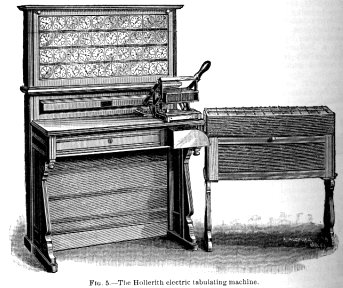IBM and the 1890 Census
Today, the U.S. census points us toward the computer. The University of Houston's College of Engineering presents this series about the machines that make our civilization run, and the people whose ingenuity created them.
We ran our first census in 1790. Agents went door to door, asking four questions. How many in this house are free white males over 16? How many are free white males under 16? How many are free white females? And how many are slaves or other persons? Those agents counted just under four million people.
That number had risen to forty million by 1870, and we were collecting 14 pieces of data about each person. In 1790 we gathered one line of data per household. Now we collected several lines per person. Census-taking was a hundred times harder, and the accuracy was slipping as well.
In 1879 Herman Hollerith joined the Census Office. He was only 20, and the Office was a world of endless copying and tallying. Imagine the problem. Someone asks, "What percent of our population are Irish immigrants?" How do you get an answer from millions of data sheets? The idea of mechanical sorting was only a dream. No one had a workable method.
One person had tried making ink marks on a continuous roll of paper. Hollerith improved that by punching holes in the paper, like a player-piano roll. Those holes could be used to register each piece of data mechanically, the way player-piano notes are sounded. But those methods lost the identity of individual records. They opened the door to really nasty errors.
One day, Hollerith talked with John Billings, a doctor in charge of health statistics. Billings said, "There should be a way to use separate cards, with notched edges, to keep track of data." Bingo! Hollerith saw it. He developed a system for punching all the data for each person into a single card. If you were a citizen, and literate, one hole went in column 7, row 9.
There was much more to it than that. Still, he had a full system working in time for the 1890 census. He invented efficient means for punching cards. He showed how to read the cards electrically. By 1890 an operator could punch 500 cards a day. He could tabulate, or read, 8000 cards a day. By 1900, he'd added automatic tabulators.
If you took up the computer more than a decade ago, then you've also worked with Hollerith cards. Not long ago, you typed each Fortran command on its own card. A machine tabulated your cards and sent your program to the computer.
You see, Herman Hollerith eventually left the Census Office to form his own company. He called it International Business Machines -- IBM. And that's why the computer age rode in on those wonderful old 1890 Census cards.
I'm John Lienhard, at the University of Houston, where we're interested in the way inventive minds work.
(Theme music)
Reid-Green, K.S., The History of Census Tabulation. Scientific American, February 1989, pp. 98-103.
This program has been rewritten as Episode 1145.

From Appleton's Cyclopaedia of Applied Mechanics, 1892